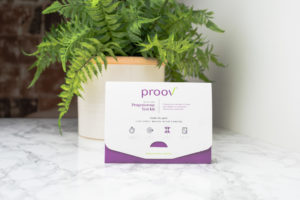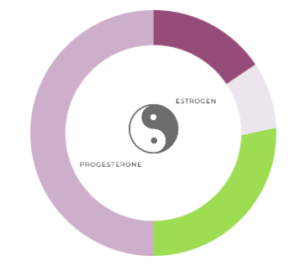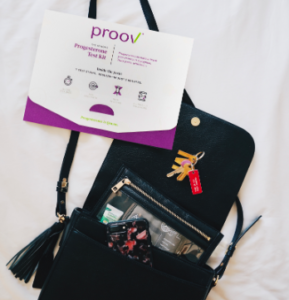Trigger warning: The below content discusses topics related to trying to conceive, including related challenges and mention of pregnancy loss. Please be advised before reading on.

So, you might be at the point in your life where you’re ready to start having children – great! Or, maybe you just want to know more about your cycle – also great! As a curvy woman, you may think you’ll automatically have a difficult time conceiving or that you’ll have to lose a significant amount of weight before trying. These statements simply aren’t true – many couples spend a year or more trying to conceive naturally, regardless of their size. And being curvy doesn’t automatically mean you will face any challenges; plenty of curvy women get pregnant no problem!
However, it’s important to be aware of additional challenges that may come up when TTC so that you’re as prepared as possible. But not to worry! We’re here to provide some information on best practices and challenges of TTC.
Best Practices for Trying to Conceive
 Let’s review some general tips when trying to conceive – these are things women should do to have her best chance at conception.
Let’s review some general tips when trying to conceive – these are things women should do to have her best chance at conception.
Finding Your Fertile Window:
Your fertile window is the time each cycle when you can get pregnant! More specifically, it is the few days out of your regular monthly cycle when an egg is most likely to be released and ovulation occurs. In the photo above from the Clue app, the fertile window is predicted in blue, with ovulation as the “star.”
When an egg is released, it travels up the fallopian tube and into the uterus. For all the trying to conceivers, this is the time to have intercourse! If all goes right, sperm and egg unite in the fertile window period and implantation of the fertilized egg can successfully occur – the start of something beautiful. There are a ton of tools and methods you can use to find your fertile window, including ovulation predictor kits (LH tests) or cervical mucus monitoring.
Confirming Ovulation:
While determining your fertile window is important in knowing when to have sex, it unforunately doesn’t tell you if ovulation has actually occurred. And without proper ovulation, there’s a very slim chance of getting pregnant. Confirming ovulation is key!
Proov tests are the first and only FDA cleared PdG test kit that confirms ovulation. PdG is a urine metabolite of progesterone, the hormone that is released by the empty follicle after ovulation. Positive Proov test results observed 7-10 days post ovulation means successful ovulation has occurred! Proov tests are urine based and non-invasive, which means you can test multiple days in a row – important information to have as PdG levels must stay elevated after ovulation to support an embryo should it be fertilized.

Tracking Data Over Time:
Using these tools to predict and confirm ovulation are so necessary in understanding your fertility and tracking the results is a crucial component! The Proov app allows you to measure, track, analyze, and view data in a convenient, easy to use platform. Unlike period tracking apps, Proov reads test results and shows measurable data from your results so you can get accurate answers easily and quickly.
Not knowing if there’s a thin faint line can cause a lot of frustration. Is it negative? Is it positive? The Proov app takes out the guesswork. The app takes pictures of Proov PdG strips and your brand’s LH strips and reads results in seconds.
Download Proov app
Challenge of TTC: Polycystic Ovarian Syndrome (PCOS)
 Polycystic Ovarian Syndrome (PCOS) is a well-known issue in the fertility community. While plus sized women are more susceptible to developing PCOS, between 5-10% of all women have PCOS. Women with PCOS have higher levels of androgens (male sex hormones), which causes an imbalance in reproductive hormones. This imbalance can prevent an egg from developing fully or the ovaries from releasing an egg – a.k.a. ovulation – during the menstrual cycle. Without ovulation, there is no chance of conception.
Polycystic Ovarian Syndrome (PCOS) is a well-known issue in the fertility community. While plus sized women are more susceptible to developing PCOS, between 5-10% of all women have PCOS. Women with PCOS have higher levels of androgens (male sex hormones), which causes an imbalance in reproductive hormones. This imbalance can prevent an egg from developing fully or the ovaries from releasing an egg – a.k.a. ovulation – during the menstrual cycle. Without ovulation, there is no chance of conception.
When ovulation is healthy, the empty follicle produces progesterone to help prepare the uterus for implantation (should the egg be fertilized). If an egg isn’t developed or released as it should be, this is considered insufficient ovulation which can result in suboptimal progesterone levels. When insufficient ovulation occurs, it can be very difficult to successfully conceive.
Hormones Estrogen and Progesterone
 Estrogen and progesterone are the yin to the other’s yang – both need to have good levels for a healthy cycle! During the first half of your cycle – the follicular phase – estrogen is high, while progesterone is low. This causes a surge of energy and productivity! During the second half of your cycle – the luteal phase – progesterone rises and estrogen drops. High progesterone levels cause a calming sense, increased mindfulness, and promote creativity. This hormone balance is imperative when TTC! Too much of either can cause an unhealthy fertile environment.
Estrogen and progesterone are the yin to the other’s yang – both need to have good levels for a healthy cycle! During the first half of your cycle – the follicular phase – estrogen is high, while progesterone is low. This causes a surge of energy and productivity! During the second half of your cycle – the luteal phase – progesterone rises and estrogen drops. High progesterone levels cause a calming sense, increased mindfulness, and promote creativity. This hormone balance is imperative when TTC! Too much of either can cause an unhealthy fertile environment.
An important thing to note is higher estrogen levels. If there are a higher number of fat cells in the body, this causes high risk for high estrogen levels. Fat cells produce estrogen and too much estrogen can cause the body to react as if you’re taking hormonal birth control. Simply put, too much estrogen can prevent you from ovulating properly or even having your regular period. Understanding your hormone levels is so important, even if you aren’t TTC!
It all comes down to ovulation
 Knowing both when and if you’ve ovulated is the best place to start when TTC. Understanding your fertile window, confirming ovulation, and tracking your results can give you powerful information over your cycle!
Knowing both when and if you’ve ovulated is the best place to start when TTC. Understanding your fertile window, confirming ovulation, and tracking your results can give you powerful information over your cycle!
Proov is the first FDA cleared at-home PdG test kit that confirms ovulation. Proov measures PdG (progesterone metabolite) that only rises after an egg has been released. Remember healthy ovulation? Proov can confirm that as well, as PdG levels must stay elevated for several days to ensure your body is hormonally prepared for conception.
If your Proov tests are positive during the testing window, then great! Lack of ovulation is likely not preventing you from conception. However, if a few or all of your Proov tests are negative during the testing window, you now have evidence to bring to your doctor to help you get better treatment, faster.
Every person has their own unique journey when trying to conceive, and by taking action against risks early, you can get pregnant faster!
Questions? Please reach out to info@proovtest.com or join Proov’s Facebook community group! We’re here to help.



